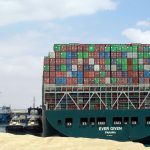On March 23, at about 7:40 a.m., the Ever Given, a 1,300-foot container ship, veered to the right as it was traversing the Suez Canal, wedging its bow into the canal wall and triggering a major rescue effort.
Since then, it has blocked all traffic between the Red Sea and the Mediterranean, a major shipping route between Asia and Europe, disrupting supply chains and prompting shippers to decide whether to spend the extra time and fuel needed to go the long way around, via the Cape of Good Hope.
Where is the Suez Canal?
The Suez Canal cuts through Egypt, linking the Mediterranean Sea in the north to the Red Sea in the south. It is one of the world’s best-known and most important waterways. Nearly 19,000 vessels passed through the canal last year carrying some 1.2 billion tons of cargo. As much as 13% of maritime trade passes through the Suez Canal, including a large proportion of the world’s oil.
Who controls the Suez Canal, and why is it important?
The Suez Canal Authority, an Egyptian state institution, operates the channel. France first controlled the canal, when the initial version was completed in 1869, during Ottoman rule in Egypt. It cuts the shipping time between Europe and Asia by about two weeks, compared with the alternative route around the Cape of Good Hope, at the southern tip of Africa. Egypt’s then-leader, President Gamal Abdel Nasser, nationalized the canal in 1956, prompting the U.K., France and Israel to invade the canal zone in an attempt to secure control before accepting Egypt’s authority over the channel after the U.S. and other countries intervened. Egypt’s move was instrumental in fomenting a wave of Arab nationalism across the Middle East. The canal remains an important source of revenue for Egypt, generating billions of dollars in fees each year, although an expansion project launched by the country’s current leader, President Abdel Fattah Al Sisi, hasn’t provided the financial boost he hoped for.
How did the cargo ship get stuck in the Suez Canal?
The Ever Given was moving north up the canal toward the Mediterranean Sea when it was caught in a dust storm where wind speeds reached 40 knots, according to a person familiar with the incident. Its bow then veered into the right side of the channel, becoming embedded in the canal wall and wedging the vessel across almost the entire width of the channel. The Suez Canal Authority has said the high wind speeds were a factor in causing the accident, but it is also investigating whether human error or technical malfunctions might also have played a role.





